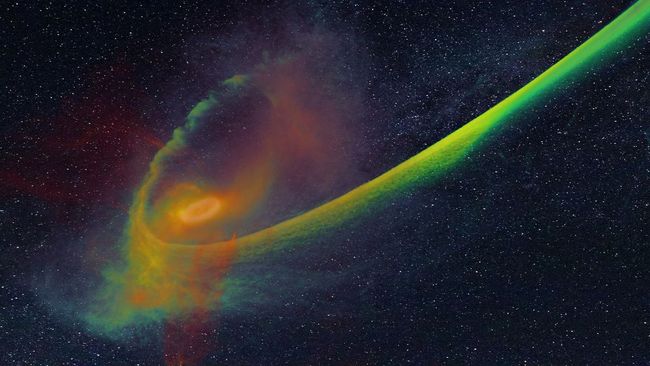Researchers Replicate the Complete Process of a Star Being Spaghettified by a Black Hole
A fresh cosmic crime scene reconstruction unveils the complete narrative of a star that was torn apart by an insatiable black hole, exposing a hitherto undisclosed facet of these tidal disruption events.

A group of scientists from the Racah Institute of Physics at the Hebrew University of Jerusalem have utilized an advanced simulation to recreate the violent demise of a star that strayed too close to a supermassive black hole and was torn apart. This team, under the leadership of researchers, has successfully narrated the entire sequence of events in what is known as a tidal disruption event (TDE) for the first time. During this gruesome process, they observed the occurrence of an unprecedented type of shock wave. Furthermore, they discovered that the dissipation of these shock waves generated an exceptionally intense burst of light during the event’s most luminous weeks.
Apart from shedding light on the brightest phases of these destructive events involving stars, these findings have the potential to assist astronomers in uncovering the characteristics of supermassive black holes, such as their mass and rate of rotation. Additionally, they can be instrumental in testing the boundaries of Einstein’s theory of general relativity.
The findings were published Jan. 17 in the journal Nature.
Black-hole-destroyed stars get a shock
Tidal disruption events (TDEs) occur when a star’s orbit brings it close to a supermassive black hole, which has a mass millions or billions of times greater than that of the sun. As the star approaches the black hole, the immense gravitational pull of the black hole generates powerful tidal forces within the star.
These tidal forces are strongest on the hemisphere of the star closest to the black hole, resulting in a significant difference in gravitational force compared to the farther end. Consequently, the star gets stretched vertically while being compressed horizontally. This process transforms the star into a thin strand of stellar plasma, commonly referred to as “spaghettification.”
The spaghettified plasma then falls back towards the black hole, undergoing heating due to a series of shock waves. As a result, the plasma emits an incredibly bright flare that can outshine the combined light of all the stars in the surrounding galaxy for weeks or even months.
Scientists from the Racah Institute of Physics, Elad Steinberg and Nicholas Stone, have developed a simulation that delves deeper into TDEs. This simulation provides a comprehensive understanding of these events, starting from the star’s capture by the black hole, through the initial disruption of the star, until the TDE flare reaches its peak.
The utilization of cutting-edge radiation-hydrodynamics simulation software, pioneered by Steinberg, made it feasible to reconstruct this event. The investigation of the cosmic crime scene unveiled a hitherto unknown form of shock wave that transpires during TDEs, indicating that these occurrences disperse energy at a more rapid pace than previously believed. This discovery informed the team that the most luminous phases of TDEs are fueled by these shock waves and the subsequent dissipation of energy.
As per the scientists, astronomers can further delve into the mechanics of these potent shock waves by analyzing real-world observations of the intense interactions between supermassive black holes and ill-fated stars.
This article is republished from SpaceCom under a Creative Commons license. Read the original article.
Do not forget to share your opinion with us to provide you with the best posts !



0 Comments